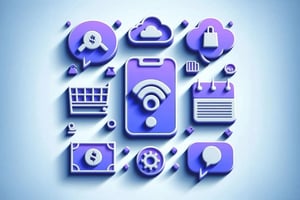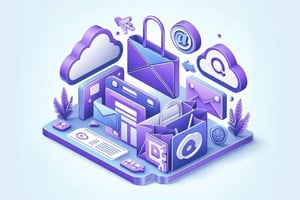In the fast-paced world of ecommerce, post-purchase SMS flows are an efficient tool for brands...
A Guide to Post-Purchase Emails: Driving Customer Retention & Lifetime Value (LTV)

In the world of ecommerce, it's easy to get caught up in the thrill of the sale and not focus on optimizing the customer journey beyond that point. However, it's important to remember that the customer journey doesn't end at the sale. The post purchase period is a goldmine of opportunity for fostering customer loyalty, driving repeat purchases and ultimately, maximizing customer lifetime value (LTV).
Post purchase emails are more than just transactional confirmations and shipping notifications. They're your direct line to engage with customers when they're most excited about your brand. By crafting a strategic sequence of emails that nurture, educate and delight, you can turn one-time buyers into loyal fans who contribute significantly to your bottom line.
In this article we'll walk through the full spectrum of post purchase emails – from the essential confirmations to personalized recommendations and feedback requests. We'll discuss optimization strategies, advanced tactics and actionable tips to help you craft an email sequence that not only enhances the customer experience but also fuels long term, profitable growth for your ecommerce brand.
The Value of Post Purchase Emails
Often overlooked, the post purchase period is a golden opportunity for ecommerce brands to build stronger bonds with customers and significantly increase lifetime value (LTV). While order confirmations and shipping notifications are essential, they merely scratch the surface of what post purchase emails can achieve.
Unlike generic marketing emails that often get lost in the inbox, post purchase messages get exceptionally higher open and engagement rates. Why? Because customers are already invested in the interaction. They're eager for updates, curious about related products and open to hearing more from the brand they just trusted with their money.
By leveraging this heightened interest, post purchase emails become a powerful tool for:
- Solidifying Trust: Providing timely updates and addressing any concerns builds confidence in your brand.
- Driving Repeat Business: Personalized recommendations, relevant content and exclusive offers can spark further purchases.
- Building Brand Advocates: Positive post purchase experiences turn satisfied customers into loyal fans who sing your praises and refer their friends.
A well crafted post purchase email strategy should not be a standalone tactic, it's an integral part of a comprehensive customer lifecycle marketing approach. By nurturing the relationship beyond the initial transaction, you create a continuous cycle of engagement, purchase and loyalty, ultimately driving significant LTV growth.
Types of Post-Purchase Emails
Your post purchase email sequence should perfect like a well-choreographed dance, each step building upon the last to create a lasting impression and guide customers back for an encore.
Here's a breakdown of some of the key emails to include:
-
Order Confirmation: The essential first step. Provide a clear summary of their purchase, including order number, items and shipping details. This is your chance to:
- Reassure the customer their purchase was successful.
- Set expectations for delivery timeframes.
- Subtly cross-sell or upsell related products.
- Infuse your brand voice with a personalized "thank you" message.
-
Shipping Confirmation: Keep customers in the loop with:
- Tracking information and estimated delivery dates.
- Anticipation-building content (e.g., "Your new shoes are on their way! Here's some outfit inspiration for when they arrive.")
-
Delivery Confirmation: More than just a notification, this email can:
- Confirm successful delivery.
- Encourage product reviews and social sharing.
- Offer a discount code for their next purchase.
-
Thank You/Appreciation Email: Express genuine gratitude and go the extra mile:
- Share a heartfelt thank-you message.
- Offer a discount code for their next purchase or introduce them to your loyalty program.
- Highlight ways they can stay connected with your brand (social media, newsletter, etc.).
-
Product Education and Tips: Help customers get the most out of their purchase:
- Provide how-to guides, tutorials, or care instructions.
- Showcase complementary products or accessories.
- Offer styling tips or usage ideas.
-
Feedback Request: Demonstrate that you value their opinion and want to improve:
- Send a short survey or a simple email requesting feedback on their experience.
- Thank them for their time and let them know you'll use their feedback to make changes.
-
Replenishment Reminders: (For consumable products)
- Send a friendly reminder when it's time to restock on their favorite items.
- Offer a discount or free shipping to incentivize a repeat purchase.
-
Win-Back Emails: For customers who haven't purchased in a while:
- Craft personalized messages that acknowledge their absence.
- Offer incentives or tailored product recommendations to re-engage them.
- This article covers more detail on identifying and building lapsed customer win-back sequences.
-
Social Proof Emails: Leverage the power of customer testimonials:
- Feature reviews and ratings of the products they purchased.
- Share user-generated content related to their items.
- Highlight your overall positive brand reputation to build trust.
Quick Tip: Each of these emails can be further optimized with hyper-personalization techniques, like using the customer's name, location, referencing past purchases or suggesting products based on browsing behavior. LTV.ai helps achieve this 1-1 communication at scale.
Optimizing Post-Purchase Emails for Maximum Impact
Crafting the right types of post-purchase emails is just the beginning. To truly maximize their impact on customer retention and LTV, optimization is key.
Here's how to ensure your emails are operating at optimum efficiency:
Personalization: The Key to Relevance
Most brands stop at referencing their customers by name, which is a simple and effective way to make them feel seen and valued. But true personalization goes far beyond that:
-
Tailor Recommendations: Use purchase history and browsing behavior to suggest products that align with their unique interests. If they bought a pair of running shoes, don't recommend hiking boots – show them the latest running apparel or accessories that would go well with their running shoes for the upcoming season.
-
Segment Strategically: Divide your customers into distinct groups based on their demographics, purchase patterns, and preferences. Send targeted emails that resonate with each segment's specific needs.
LTV.ai helps achieve this at scale by personalizing each individual email (mentioning location, past feedback & tailored product suggestions) and holding conversations with customers, to drive repurchases & increase owned channel sales by 10-25%.
Content: More Than Just Marketing Fluff
Every post-purchase email is an opportunity to reinforce your brand identity and provide value. Here's how to optimize your content:
-
Compelling Subject Lines: Pique their curiosity with personalized subject lines that promise value or intrigue (e.g., "Sarah, your exclusive [customer city] discount awaits!" or "How did you like your [product name]?").
-
Clear and Concise Copy: Get to the point quickly. Use your brand voice but keep the language easy to understand and focused on the message.
-
Visual Appeal: High-quality product images, clean layouts and engaging visuals enhance the overall experience and make your emails more enjoyable to read.
-
Value-Driven Content: Offer more than just sales pitches. Share styling tips, product care guides, user-generated content or customer testimonials to ensure your customers are getting the absolute most out of their purchase and your brand. This establishes your brand as a trusted source of information and inspiration.
Call-to-Action (CTA): Guide Them to the Next Step
Don't leave your customers guessing. A clear and compelling CTA guides them towards the action you want them to take:
- Strong Verbs: Use action-oriented language like "Shop Sweater", "Discover More" or "Leave a Review".
- Create Urgency: If your offer is time-sensitive, let them know! (e.g., "Don't miss out – sale ends in 3 days!")
- Personalize It: Consider using a personalized CTA based on their past purchases or interests (e.g., "The Perfect Summer Top To Go With Your Green Sneakers"). LTV.ai helps achieve this at scale.
The goal of optimization is to increase engagement and drive conversions. By personalizing content, crafting compelling subject lines / CTAs and offering value beyond just discounts, you'll transform your post-purchase emails into efficient retention tools that foster loyalty and increase customer LTV.
Further Optimization & Advanced Strategies for Larger Brands
Going beyond the basics requires a deeper understanding of customer behavior and leveraging automation and personalization to create hyper-targeted campaigns that drive engagement and LTV.
Behavioral Triggers: The Right Email at the Right Time
Go beyond simple post-purchase sequences. Implement behavior-triggered emails that respond to specific customer actions:
- Abandoned Cart: Remind customers of items they left behind, offer a small discount or showcase related products.
- Post-Purchase Cross-Sell/Upsell: Suggest complementary products or upgrades shortly after a purchase.
- Customer Feedback: Send an email a few days after delivery to request a review or feedback.
- Re-engagement: If a customer hasn't purchased in a while, trigger an email with a personalized offer or curated selection of new products.
Dynamic Content: Real-Time Personalization
Dynamic content allows you to personalize email content in real-time based on individual customer behavior and preferences. This takes hyper-personalization to the next level.
For example:
- Show Recently Viewed Products: Remind customers of items they've recently browsed.
- Display Location-Specific Offers: Show relevant products or deals based on the customer's location.
- Adjust Content Based on Purchase History: Offer recommendations that align with their past purchases or interests.
A/B Testing: The Key to Continuous Improvement
Don't settle for a "good enough" email strategy. Continuously experiment and optimize by A/B testing different elements:
- Subject Lines: Test different wording, personalization tactics and emojis to see what drives the highest open rates.
- Email Content: Experiment with different layouts, product features and offers to see what resonates best.
- Send Times: Analyze when your emails are most likely to be opened and clicked on to optimize delivery times.
- Segmentation Strategies: Test different segmentation approaches to ensure you're targeting the right customers with the right messages.
Multi-Channel Integration: The Power of SMS and Beyond
Don't limit yourself to just email. Integrate your post-purchase strategy with other channels like SMS to reinforce your message and create a more cohesive customer experience.
Over at LTV.ai, an example of our multi-channel approach is as follows:
- Send initial email presenting an offer or driving their attention towards the action we want them to take.
- Send a follow-up SMS reminding customers of an exclusive offer mentioned in an email and offering alternative offers / courses of actions.
Other common ways include:
- Use SMS for shipping updates or delivery notifications to ensure your messages are seen promptly.
- Use SMS for urgent upsells to ensure the customer has access to the best complimentary products.
- Use SMS for feedback gathering to ensure your message is seen and it's convenient for the customer to reply.
By leveraging the strengths of each channel and tailoring your approach to individual preferences, you can create a truly omnichannel experience that drives engagement and increases LTV.
Key Takeaways
- Post-Purchase Emails Are a Goldmine: They're not just receipts, they're your tool for maximizing customer lifetime value (LTV).
- Personalization is Paramount: Go beyond the basics. Tailor recommendations, offers and messaging to each individual's preferences and past purchases.
- Embrace the Sequence: Map out a strategic email flow that guides customers from purchase to repeat purchase.
- Variety is Key: Don't just send promotions. Include educational content, feedback requests and social proof to nurture relationships and foster loyalty.
- Optimize and Iterate: Continuously test and refine your approach based on data and customer feedback.
- Embrace Omnichannel: Combine email with SMS and other channels for a seamless, personalized experience.
By mastering the art of post-purchase emails, you can transform one-time buyers into loyal brand advocates who contribute significantly to your bottom line.
The one main takeaway we want you to remember is that the customer journey doesn't end at checkout – it's just the beginning.






